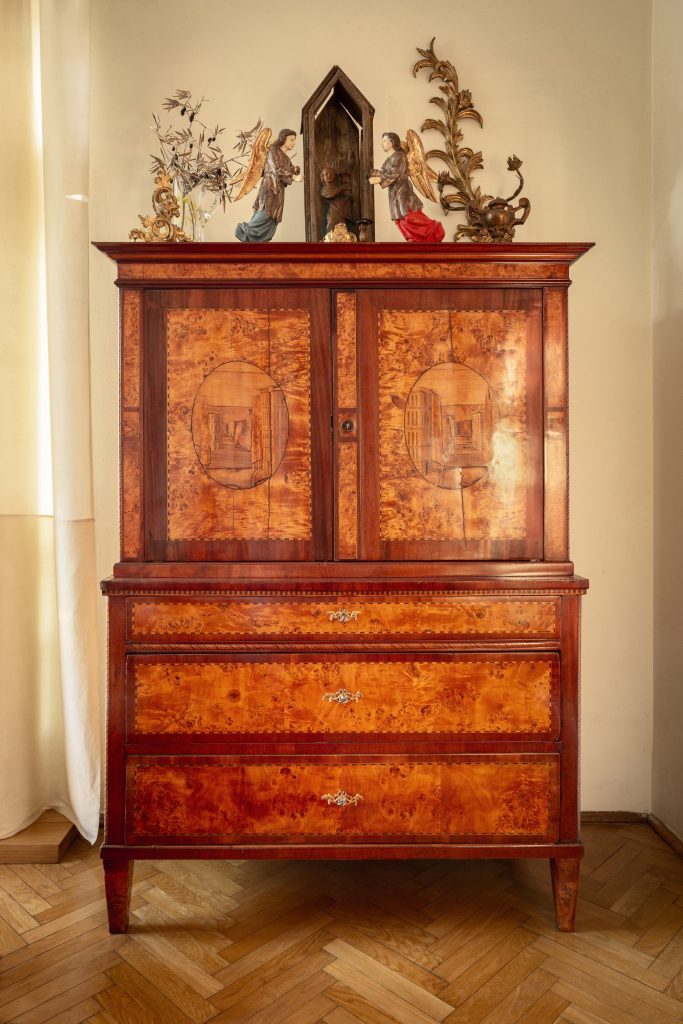April 15, 2023, 11:22 am | Read time: 4 minutes
The Biedermeier period was marked by unrest in the country and a shift from public to private spaces. Homes were meant to become beautiful retreats. These aspirations also influenced the architecture and furniture design of the time.
To this day, the Biedermeier period is well-known, even though it dates back several centuries and was not particularly long-lasting. Nevertheless, the era had a significant impact on art, literature, and music, but especially on architecture and furniture design. So, what characterizes this era, and what makes the Biedermeier period still so special?
What Characterizes the Biedermeier Era?
The Biedermeier period is placed in the first half of the 19th century. Notably, the year 1815 marked the end of decades of wars and unrest in Europe. The Congress of Vienna saw the conservative victorious powers negotiate the reorganization of Europe. What followed was the period of restoration and a return to traditional values.
The goal was to restore the time before the French Revolution, much to the dismay of the people and the delight of the church, which gradually regained significance. Political interest among the population was correspondingly low at that time. Instead, people preferred to retreat into their private lives and turn their homes into idyllic sanctuaries–while problems outside continued to grow. In 1848, a new revolution in Germany marked the end of the Biedermeier period. The population now wanted to participate more actively in the country’s political events and help shape them.
How Did the Style Get Its Name?
Today, when we speak of Biedermeier, we refer less to the historical era and more to the arts of that time. A unique culture developed within the bourgeoisie, producing musical and literary works, as well as buildings and furniture designs, that are still known today. However, what connected all the arts was a strongly conservative influence, which is why one could rightly speak of modest circumstances. The word “bieder” (meaning conservative or plain) is not from that time but came later.
“Herr Biedermeier” referred to the fictional character of a Swabian village teacher named Gottlieb Biedermaier (the spelling later changed to “ei”). This literary figure, created by writer Ludwig Eichrodt, represented the characteristics of the prevailing time: a man who lived in simple circumstances yet seemed content with his life. For a long time, these traits were negatively connoted as narrow-mindedness and political disinterest. After 1900, the perspective shifted to a more neutral view, interpreting it instead as a retreat into private life and the associated domesticity of the petite bourgeoisie.
Also interesting: How Art Nouveau Still Influences Architecture Today
Features of Biedermeier Architecture

As the population became depoliticized, people increasingly retreated into their own homes. They wanted to make their homes as beautiful and comfortable as possible. This led to a transformation in the prevailing architecture. The architectural style of this era was reminiscent of antiquity and was a form of classicism. Because modesty and humility were important characteristics of the Biedermeier era, the buildings of that time appear more simple than ornate.
Thus, the architectural style is considered elegant and free from excessive opulence. Additionally, the return to private life resulted in the construction of larger living rooms. This provided enough space to spend time with family. In a way, this space became the precursor to today’s living room. During the Biedermeier period, numerous buildings were constructed, some of which still shape urban spaces today.

What Makes Louis XVI Style Furniture So Special Today?

How Art Nouveau Continues to Influence Architecture Today

What characterizes an apartment from the Gründerzeit era?
Unadorned Furniture in an Elegant Style

To ensure at least an idyllic private life during a conservatively influenced time, interior design also underwent stylistic changes. Notably, the furniture was of remarkably high quality, which is why the Biedermeier period is also considered a very tasteful era. The well-crafted furniture pieces–like the architecture–represent a lot of simple elegance.
This was expressed through generous, smooth veneer surfaces with clearly visible grain. Accordingly, fine woods like walnut, mahogany, and cherry were used. Gold-plated fittings served as accents, but in a modest measure. Typical Biedermeier furniture included chests of drawers, secretaries, and small tables. The form was always kept straightforward and unadorned. To meet the cozy character and the need for harmony of that time, comfortable upholstered furniture made from high-quality fabrics was also a focus.


